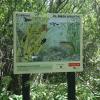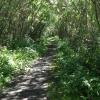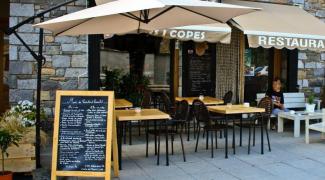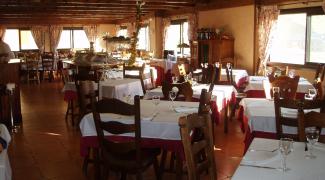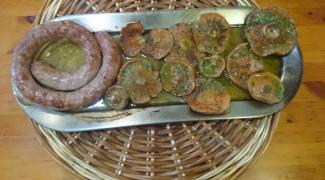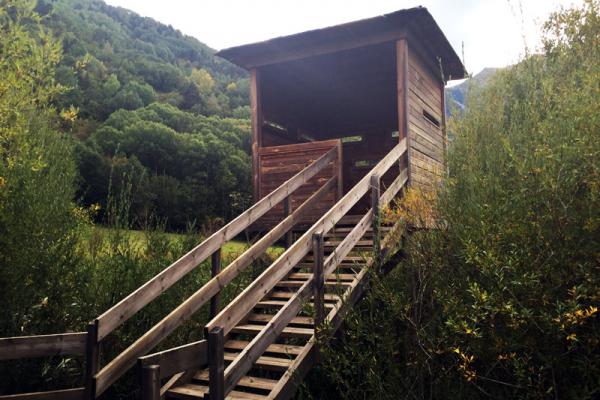
The Salencar de Barruera Trail
- Departure: Suspension bridge of Barruera
- Arrival: Suspension bridge of Barruera

- Distance: 1.5 km
- Duration: 1h00
- Incline: 0 m
- Degree of difficulty: Very easy
- Type of route: Circular
- Suitable for MTB: Yes
- Best time of year: All year
* Degree of difficulty obtained by SENDIF method
You can start the route from Barruera, through the Passeig del Riu and over the new suspension bridge that crosses the Noguera de Tor river.
Salencar de Barruera (Barruera’s willow area), also known as Cardet’s Dam, receives the waters from the Noguera de Tor, located downstream in the village of Barruera. Located 1080 metres above sea level, the distinctive feature of this mid-mountain reservoir is that it is placed in a rather open and flat spot of Boí Valley that is favourable for the growth of the surrounding vegetation, especially the willows.
The characteristics of the land and the sediment retention have given rise to a rather extended area of rushes as well as to a river forest, mainly composed of willows, principally located on the left bank and on some islands. As the retention process is progressing rather fast, the deep areas are decreasing year after year and the willow area is gaining more and more extension.
The most outstanding element of the river forest is the willow area (habitat of community interest 3240) whose main species are the following: narrow-leaved rosemary willow (Salix alba), purple willow (Salix purpurea), white willow (Salix alba), and ash (Fraxinus excelsior). The waters host vegetal areas of Potamogeton pectinatus, P. crispus, Ranunculus aquatilis, R. tricophyllus and Utricularia vesicularis.
It is also worth mentioning the hay meadows that are located on the left bank, separated by different lines of poplars, ashes and others deciduous trees (habitat of community interest 6520 “High mountain and subalpine hay meadows (Triseto-Polygonion bistortae)"). This tree-lined bank area located among hay meadows also hosts some small ponds, humid pasturelands and megaphorbic grasslands.
Wildlife is characterised by the abundance of trout larvae and adults. This area also gathers migratory birds (mainly during the spring migration) and many species of humid areas such as mallards (Anas platyrhynchos), sandpipers (Actitis hypoleucos), gallinules (Gallinula chloropus), dippers (Cinclus cinclus), kingfishers (Alcedo atthis), marsh tits (Parus palustris), etc. You might also see some amphibians like the common toad (Bufo bufo) and some mammals such as otters (Lutra lutra) and roe deers (Capreolus capreolus).
This area is thus really attractive both for its wildlife, its river forest and its vegetation of hydrophytes and helophytes.
The proximity of Barruera and the easy access through the track located along the right bank attract many motor homes (right bank), fishermen, hikers and tourists, especially since guided tours have been offered. An artificial lagoon surrounded by walkways has recently been made for the fishing lovers. Some works are being carried out on the right bank to make an urban promenade. This area also hosts a water treatment plant and a section of the Water Route.
The site is run by Fundació Territori i Paisatge (Territory and Landscape Foundation) through a territorial cooperation agreement with Boí Valley’s Town Council and offers guided tours and educational activities focused on environment. Visitors will find some information panels, a viewpoint, tables and benches, as well as marked itineraries with wooden walkways.
The area is part of the network called Xarxa Natura 2000 ES0000022 “Aigüestortes” and is located in the National Game Preserve of Alt Pallars-Aran.
<iframe frameBorder="0" scrolling="no" src="https://ca.wikiloc.com/wikiloc/embedv2.do?id=228757646&elevation=on&images=on&maptype=H" width="500" height="400"></iframe><div style="color:#777;font-size:11px;line-height:16px;">Powered by <a style="color:#4C8C2B;font-size:11px;line-height:16px;" target="_blank" href="https://ca.wikiloc.com">Wikiloc</a></div>
<iframe src="https://static-m.meteo.cat/ginys/mapaRadar?language=ca&color=2c3e50&target=_blank" title="Última imatge de radar" frameborder="0" style="border:0" scrolling="no" width="396" height="412"></iframe>





